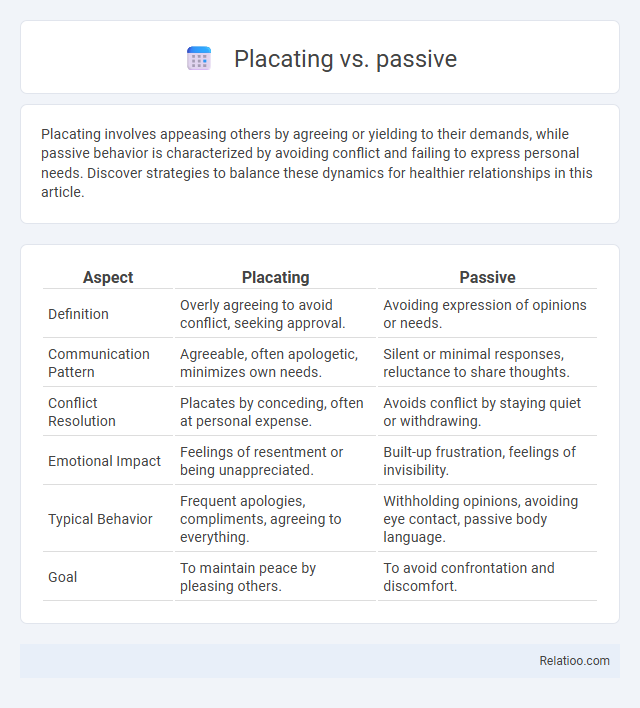Placating involves appeasing others by agreeing or yielding to their demands, while passive behavior is characterized by avoiding conflict and failing to express personal needs. Discover strategies to balance these dynamics for healthier relationships in this article.
Table of Comparison
| Aspect | Placating | Passive |
|---|---|---|
| Definition | Overly agreeing to avoid conflict, seeking approval. | Avoiding expression of opinions or needs. |
| Communication Pattern | Agreeable, often apologetic, minimizes own needs. | Silent or minimal responses, reluctance to share thoughts. |
| Conflict Resolution | Placates by conceding, often at personal expense. | Avoids conflict by staying quiet or withdrawing. |
| Emotional Impact | Feelings of resentment or being unappreciated. | Built-up frustration, feelings of invisibility. |
| Typical Behavior | Frequent apologies, compliments, agreeing to everything. | Withholding opinions, avoiding eye contact, passive body language. |
| Goal | To maintain peace by pleasing others. | To avoid confrontation and discomfort. |
Understanding Placating: Definition and Context
Placating involves soothing or calming others to avoid conflict by agreeing or appeasing, often at the expense of one's own needs. In contrast, passive behavior typically reflects avoidance or withdrawal without direct confrontation, while aggressive placating combines submission with underlying resentment. Understanding placating in contexts such as relationships or workplace dynamics offers insight into communication patterns aimed at maintaining peace but potentially fostering imbalance.
What Does It Mean to Be Passive?
Being passive means consistently avoiding confrontation and suppressing personal needs to maintain peace, often leading to unresolved conflicts and personal dissatisfaction. Passive individuals tend to prioritize others' preferences over their own, which can result in feelings of powerlessness and resentment. This behavior contrasts with placating, which involves appeasing others to gain approval, and assertiveness, where clear communication of needs occurs.
Key Differences Between Placating and Being Passive
Placating involves actively agreeing or appeasing others to avoid conflict, while being passive means withholding your opinions or needs and avoiding assertiveness altogether. Your communication style in placating attempts to maintain harmony by sacrificing your own stance, whereas passivity leads to internal suppression and potential resentment. Understanding these key differences helps you establish healthier boundaries and clearer self-expression.
Psychological Roots of Placating Behaviors
Placating behaviors stem from deep psychological roots often linked to a need for approval, fear of conflict, or childhood experiences involving inconsistent emotional support. These behaviors differ from passive and passive-aggressive responses by actively attempting to soothe or appease others to maintain peace, sometimes at the expense of your own needs. Understanding these underlying motivations can help you recognize and address placating tendencies to improve emotional well-being and assertiveness.
Why People Fall Into Passivity
People often fall into passivity as a way to avoid conflict and maintain temporary peace, especially when facing emotional stress or fear of rejection. Placating involves appeasing others at the expense of your own needs, while passive behavior reflects a reluctance to assert yourself or set boundaries. Understanding your triggers and practicing assertiveness can help break the cycle of passivity and promote healthier communication.
Impact of Placating vs. Passive Responses in Relationships
Placating responses often involve appeasing others to avoid conflict, which can lead to resentment and an imbalance of power in relationships. Passive behavior, characterized by avoiding expression of one's own needs, typically results in unmet needs and decreased relationship satisfaction. Understanding the impact of placating versus passive responses helps improve communication dynamics, fostering healthier and more equitable connections.
Recognizing Signs: Are You Placating or Just Passive?
Recognizing signs of placating versus passivity involves understanding your communication patterns and emotional responses. Placating often includes excessive agreement and self-sacrifice to avoid conflict, while passivity is marked by avoidance and reluctance to express needs or opinions. You can identify placating behavior by noticing if you tend to prioritize others' feelings over your own, which differs from the more withdrawn nature of passivity.
Consequences of Chronic Placating and Passivity
Chronic placating and passivity can lead to significant emotional exhaustion and resentment, undermining Your sense of self-worth and causing unbalanced relationships. These behaviors often result in suppressed needs and delayed personal growth, making it difficult to establish healthy boundaries or express genuine emotions. Over time, persistent placating and passive tendencies increase stress levels and contribute to mental health issues such as anxiety and depression.
Strategies to Overcome Placating and Passivity
Overcoming placating and passivity involves setting clear boundaries and practicing assertive communication to express Your needs confidently. Developing self-awareness helps identify situations where you default to appeasing others, allowing You to choose more balanced responses. Building emotional resilience and seeking supportive relationships encourages proactive problem-solving instead of avoiding conflict.
Building Assertiveness: Finding a Healthy Balance
Building assertiveness requires distinguishing between placating, passive, and assertive behaviors to foster healthy communication patterns. Placating often involves excessive agreement to avoid conflict, while passive behavior tends to suppress personal needs and opinions, leading to resentment. Developing assertiveness means expressing thoughts and feelings honestly and respectfully, balancing self-confidence with empathy to create constructive interactions.

Infographic: Placating vs Passive
 relatioo.com
relatioo.com